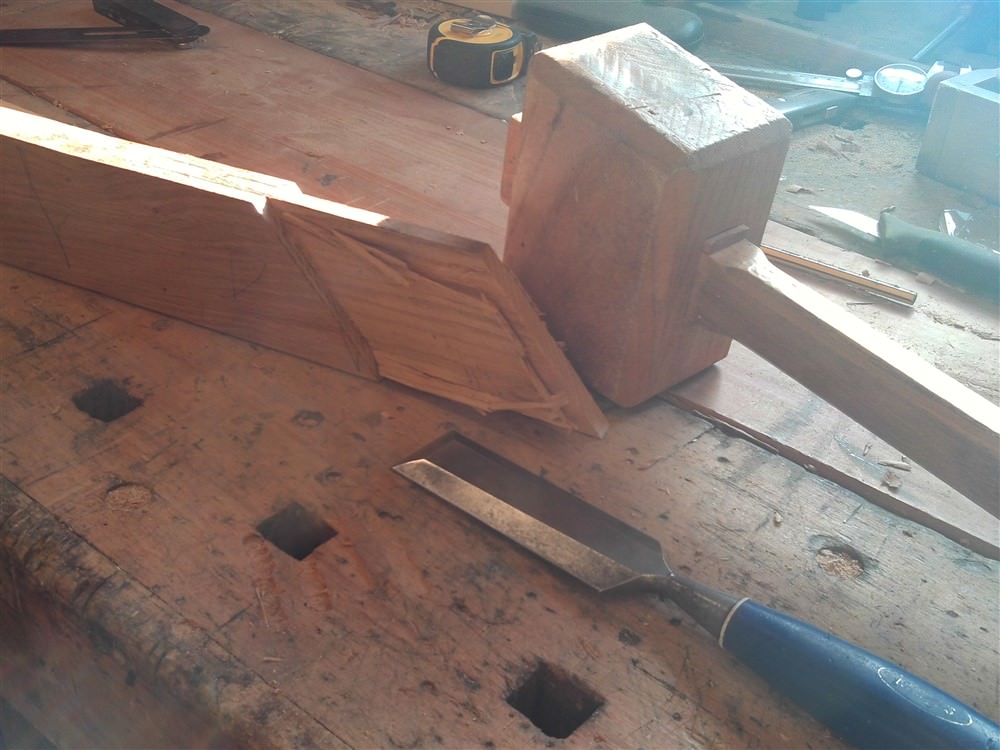Having picked up some carving chisels to try a bit of more decorative wood carving I have been meaning to get around to making myself a new mallet.
Last week my wife and I called into a Antiques/ Vintage/Upcycled type centre, you know the sort of place I'm sure, not much antique or truly vintage but lots old wooden cable drums varnished and called a coffee table for £300, there was what was once a nice old wooden try plane now a lamp, and best of all a pallet, not sanded, not painted or varnished just had 4 hairpin steel legs added and a sheet of glass on top £395. :shock:
Anyway I digress, not expecting to find much of interest then on a shelf I saw this mallet amongst other general "vintage" kitchen stuff, expecting to find a ridiculous price tage I was very surprised it was £24, got it for £22 in the end and very pleased and would have paid more.
It's 12.5" overall 4.5" at widest and very heavy, to me it has the slight green tinge of lignum vitae, but a Google search finds a dealer selling a similar but plainer mallet described as bog oak ( also asking £285!) any thoughts? As you can see someone has fairly recently glued a piece of wood into a split and badly tried to colour match it which is a shame.
I've not used it yet, its not even made the workshop, its on the table beside my chair its so very tactile and oozes history I can't put it down. (Wife keeps giving me funny looks though).
I suspect that it was either used for heavy oak framing or masonry use, I think its certainly 19c but something is niggling in my memory about the decoration that makes me think it is posiibly much older, (don't know why but Elizabethan keeps popping in to my head) any ideas?
Think I'll still have to make a slightly smaller one though.
Nick
Last week my wife and I called into a Antiques/ Vintage/Upcycled type centre, you know the sort of place I'm sure, not much antique or truly vintage but lots old wooden cable drums varnished and called a coffee table for £300, there was what was once a nice old wooden try plane now a lamp, and best of all a pallet, not sanded, not painted or varnished just had 4 hairpin steel legs added and a sheet of glass on top £395. :shock:
Anyway I digress, not expecting to find much of interest then on a shelf I saw this mallet amongst other general "vintage" kitchen stuff, expecting to find a ridiculous price tage I was very surprised it was £24, got it for £22 in the end and very pleased and would have paid more.
It's 12.5" overall 4.5" at widest and very heavy, to me it has the slight green tinge of lignum vitae, but a Google search finds a dealer selling a similar but plainer mallet described as bog oak ( also asking £285!) any thoughts? As you can see someone has fairly recently glued a piece of wood into a split and badly tried to colour match it which is a shame.
I've not used it yet, its not even made the workshop, its on the table beside my chair its so very tactile and oozes history I can't put it down. (Wife keeps giving me funny looks though).
I suspect that it was either used for heavy oak framing or masonry use, I think its certainly 19c but something is niggling in my memory about the decoration that makes me think it is posiibly much older, (don't know why but Elizabethan keeps popping in to my head) any ideas?
Think I'll still have to make a slightly smaller one though.
Nick












